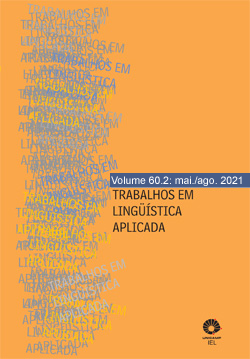Abstract
In this study we problematize the understanding of what is considered critical by the authors of a first grade of high school textbook approved by a committee for the distribution in Brazil. We also point ways of filling the gaps in said document. In line with a pedagogical approach towards queer literacy (LIN, 2014) and racial critical literacy (FERREIRA, 2015a, 2015b), we claim anti-racist problematizing practices (PENNYCOOK, 2004) must be included in language teachers’ education as well as in learning materials. Thus, our perspective on what is critical wishes to motivate questioning and “queering” (LIN, 2014) naturalized discourses considering relations of access, power, power, difference, inequality and resistance (PENNYCOOK, 2004). We analyzed the book’s unit named "Who am I?" which focuses on matters of identity, as well as the theoretical framework and guidelines for teachers. Our considerations point to the need for a curriculum that will fill in the gaps in learning materials for schools so teachers may go beyond the suggestions to actually promote anti-racist pedagogical practices, through reflecting about identity processes in an intersectional and decolonial perspective. In this case, and possibly others, the guidelines for teachers in the set do not problematize those aspects, which shows lack of questioning for a transformative agenda.
References
ABRAHÃO, A.L. et al. (2014). O Pesquisador IN-MUNDO e o processo de produção de outras formas de investigação em saúde. In: GOMES, M. P. C.; MERHY, E.E. (orgs.). Pesquisadores IN-MUNDO: Um estudo da produção do acesso e barreira em saúde mental. Coleção Micropolítica do Trabalho e o Cuidado em Saúde. Porto Alegre: Rede Unida, p. 155-170.
AOC Twitch Stream Becomes One of the Highest-Watched Ever, 2020. 1 vídeo (4min56s). Transmitido ao vivo em 23 de julho de 2020 pelo Canal Diálogos. Disponível em:. https://youtu.be/mtrAwh0fWeA Acesso em 29 out. 2020.
BRASIL. (2013). Ministério da Educação. Secretaria de Educação Básica. Diretoria de Currículos e Educação Integral. Coordenação Geral do Ensino Médio. Programa Ensino Médio Inovador Documento Orientador. Brasília. Disponível em: http://portal.mec.gov.br/index.php?option=com_docman&view=download&alias=13249-doc-orientador-proemi2013-novo-pdf&category_slug=junho-2013-pdf&Itemid=30192. Acesso em: 28 out. 2020.
FANON, F. (1969). Em Defesa da Revolução Africana. Tradução de Isabel Pascoal. Lisboa: Sá da Costa Editora, 1980.
FERREIRA, A. J. (2015a). Letramento racial crítico através de narrativas autobiográficas: com atividades reflexivas. Ponta Grossa: Estúdio Texto.
FERREIRA, A. J. (org). (2015b). Narrativas Autobiográficas de Identidades Sociais de Raça, Gênero, Sexualidade e Classe em Estudos da Linguagem. Campinas: Pontes Editores.
FERREIRA, A. J. (2018). Educação Linguística Crítica e Identidades Sociais de Raça. In: PESSOA, R. R.; SILVESTRE, V. P. V. S.; MONTE MÓR, W. (orgs.). Perspectivas críticas de educação linguística no Brasil: trajetórias e práticas de professoras(es) universitárias(os) de inglês. São Paulo: Pá de Palavra, p. 39-46, PDF.
FREIRE, P. (1967). Educação como Prática da Liberdade. In: FREIRE, P. Educação como Prática da Liberdade. Rio de Janeiro: Paz e Terra.
GEE, J. P. (1999). An Introduction to Discourse Analysis: Theory and method. Nova Iorque: Routledge, 2005.
GILL, R. (2010). Análise de discurso. In: BAUER, M. W.; GASKELL, G. Pesquisa qualitativa com texto, imagem e som: um manual prático. 8. ed. Petrópolis: Vozes, p. 244- 270.
GOMES, N. L. (2005). Alguns termos e conceitos presentes no debate sobre relações raciais no Brasil: uma breve discussão. In: OUANE, A. et al. (eds). Educação anti-racista: caminhos abertos pela Lei Federal n० 10639/03. Coleção Educação para Todos. Brasília: Ministério da Educação, Secretaria de Educação Continuada, Alfabetização e Diversidade, p. 39-64.
HOOKS, B. (2010). Ensinando Pensamento Crítico: Sabedoria Prática. Tradução de Bhuvi Libanio. São Paulo: Elefante, 2020.
INSTITUTO BRASILEIRO DE GEOGRAFIA E ESTATÍSTICA. (2020). Pesquisa Nacional por Amostragem de Domicílios Contínua 2012/2019. Disponível em: https://educa.ibge.gov.br/jovens/conheca-o-brasil/populacao/18319-cor-ou-raca.html. Acesso em: 28 out. 2020.
KIRMELIENE, V. C. C. et al. (2016). Circles 1. Livro do ela. São Paulo: FTD.
LIN, C. K. (2014). Frameworks for understanding LGTBQ-inclusive Environments. Disponível em: http://center.uoregon.edu/NCTE/uploads/2014NCTEANNUAL/HANDOUT/KEY_2013462/frameworksforUnderstandingLGBTQinclusiveenvironments.pdf. Acesso em: 03 nov. 2015.
LUKE, A.; FREEBODY, P. (1997). Critical Literacy and the Question of Normativity: An Introduction. In: LUKE, A.; FREEBODY, P. Constructing critical literacies: teaching and learning textual practice. Cresskill, New Jersey: Hampton Press, p. 1-18.
MELO, G. C. V. (2015). O lugar da raça na sala de aula de inglês. Revista da Associação Brasileira de Pesquisadores/as Negros/as (ABPN). v. 7, n. 17, p. 65-81. Disponível em: https://abpnrevista.org.br/index.php/site/article/view/72. Acesso em: 28 out. 2020.
MOITA LOPES, L. P. (2006). Linguística Aplicada e vida contemporânea: problematização dos construtos que têm orientado a pesquisa. In: MOITA LOPES, L. P. (org.) Por uma Linguística Aplicada Indisciplinar. São Paulo: Parábola, p. 85-107.
PENNYCOOK, A. (2004). Critical Applied linguistics. In: DAVIES, A.; ELDER, C. (eds.). The Handbook of Applied Linguistics. Oxford: Blackwell Publishing, p. 784-807.
POR uma "proximidade crítica" nos estudos em Linguística Aplicada. Palestrantes: Luiz Paulo da Moita Lopes e Branca Falabella Fabrício. Ceará: Diálogos, 2020. 1 vídeo (73min48s). Transmitido ao vivo em 23 de julho de 2020 pelo Canal Diálogos. Disponível em: https://www.youtube.com/watch?v=qWdcGxni8gA&feature=youtu.be. Acesso em 27 out. 2020.
SANTOS. B. S.; MENESES, M. P. (orgs.). (2009). Epistemologias do Sul. Coimbra: Edições Almedina S.A.
TILIO, R. (2017). Ensino crítico de língua: afinal, o que é ensinar criticamente? In: JESUS, D.; ZOLIN-VESZ, F.; CARBONIERI, D. (orgs.). Perspectivas críticas no ensino de línguas: novos sentidos para a escola. Campinas: Pontes, p. 19-31.

This work is licensed under a Creative Commons Attribution 4.0 International License.
Copyright (c) 2021 Trabalhos em Linguística Aplicada


